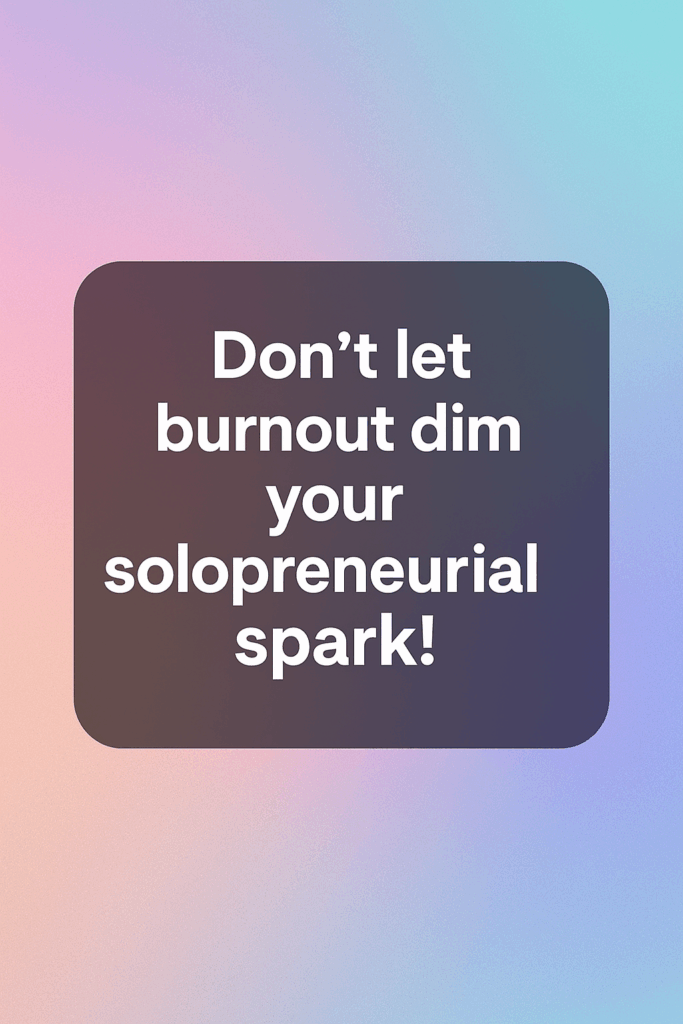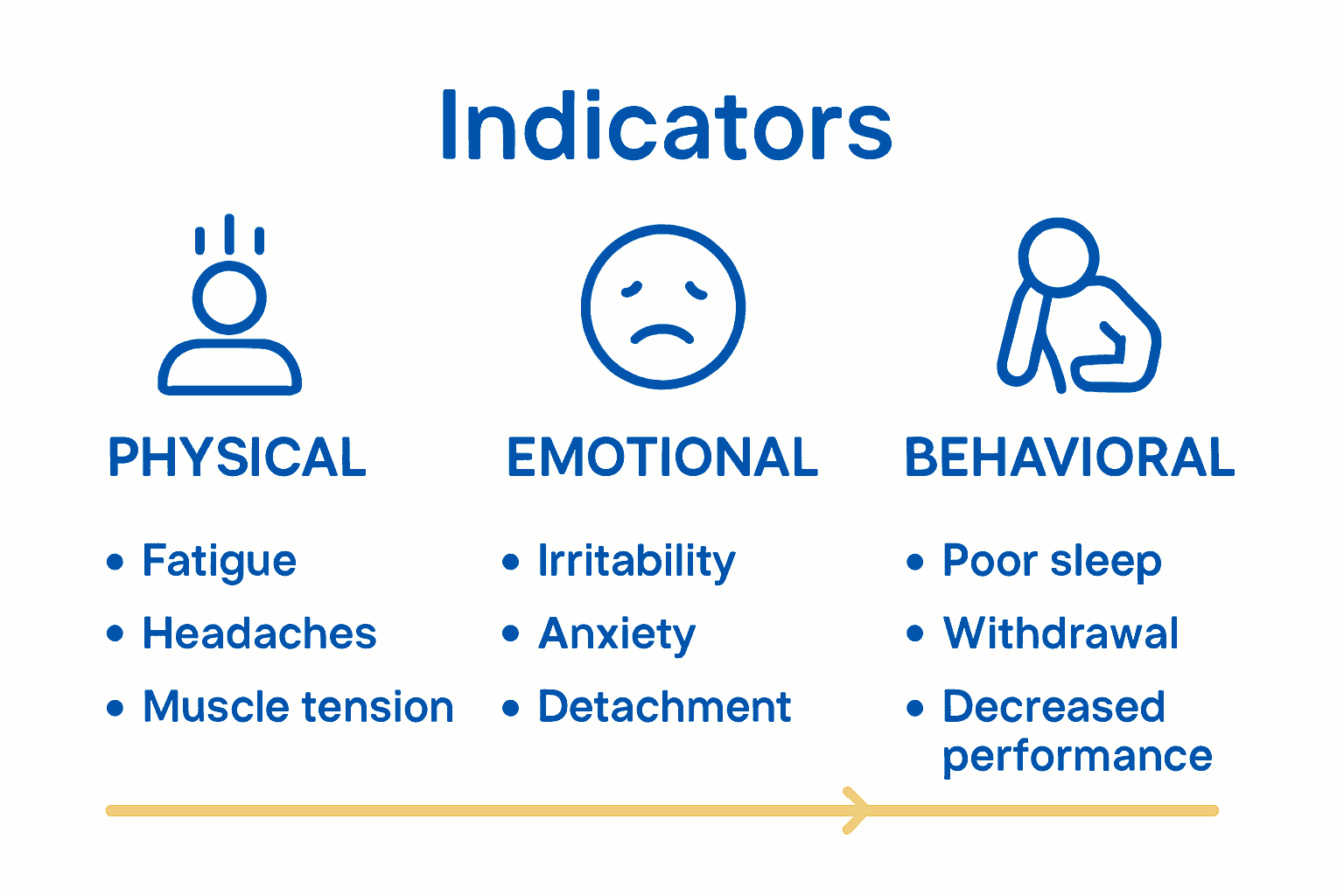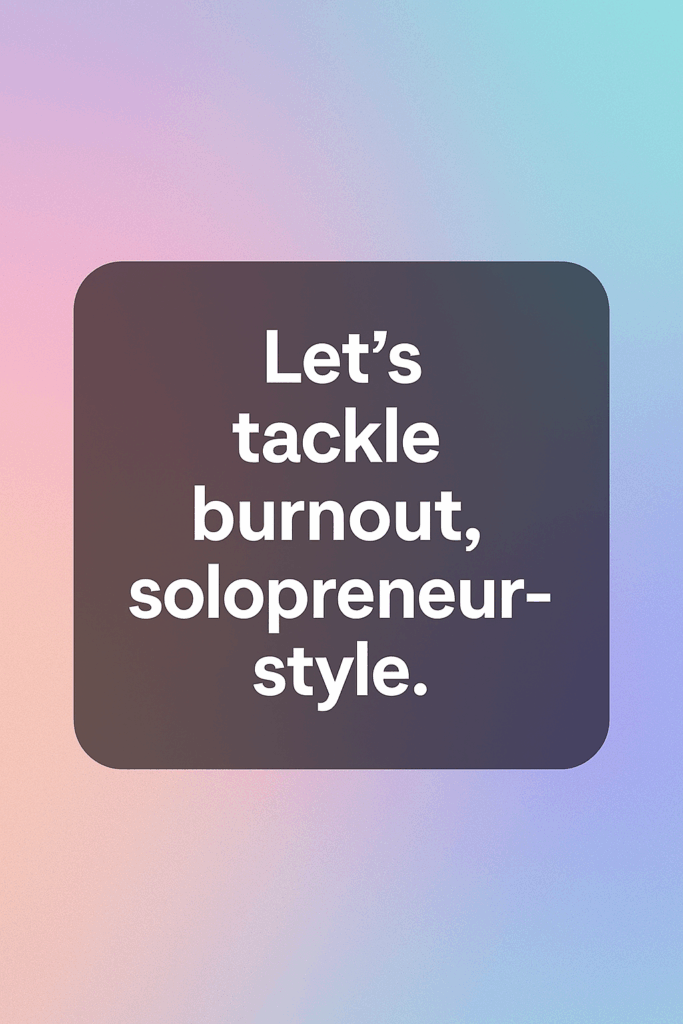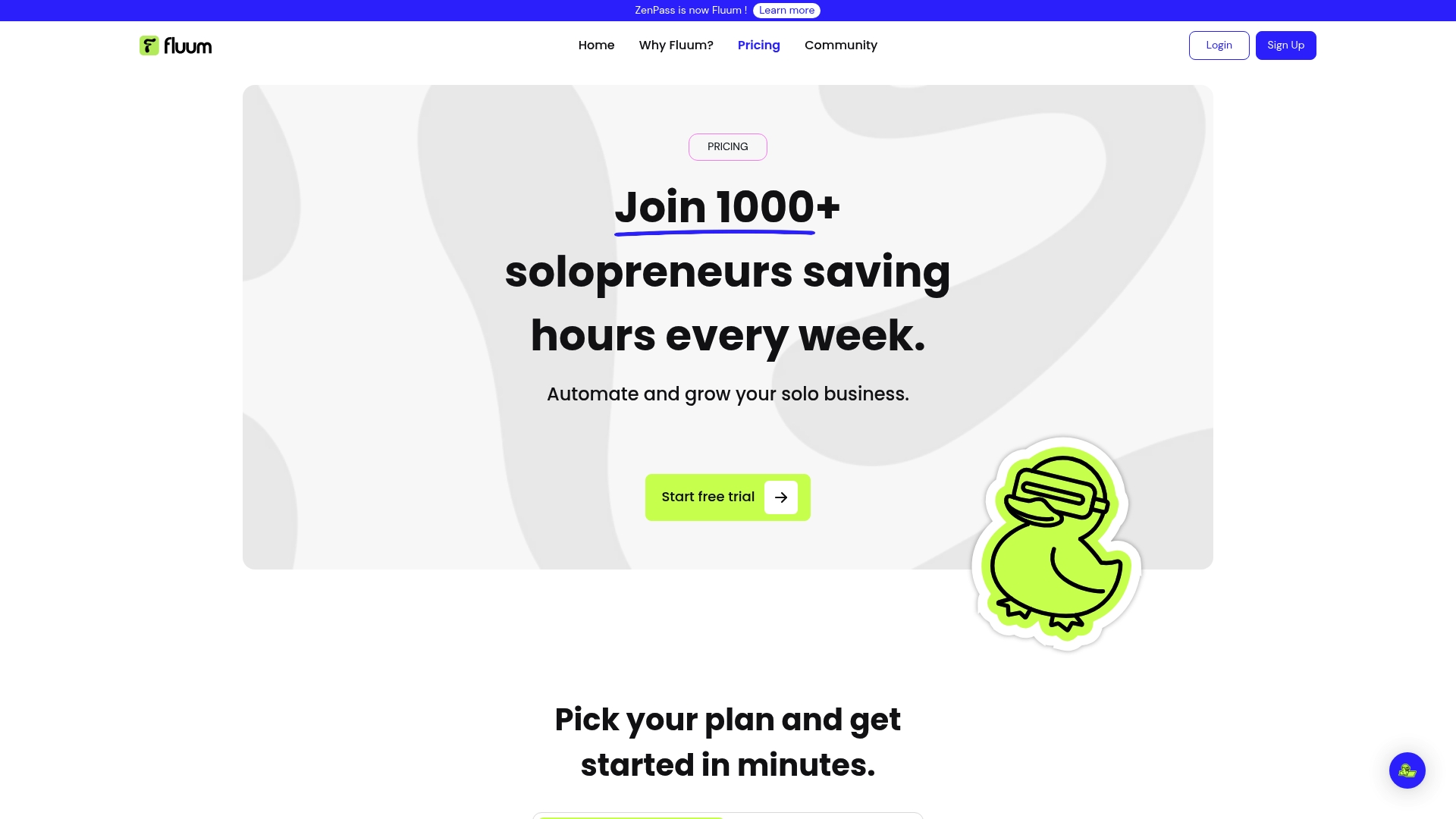
Learning how to handle burnout is so important as nearly 77 percent of solopreneurs report feeling overwhelmed by their workload at least once a month. Burnout can sneak up quietly, sapping your motivation and energy before you even realize something is wrong. By learning how to spot the earliest signs and adjust your work habits, you can protect your health and keep your business on track without sacrificing well being.
Quick Summary
| Key Point | Explanation |
|---|---|
| 1. Recognize early signs of burnout | Monitoring energy and emotions helps catch burnout before it escalates into bigger issues. |
| 2. Assess your workload and stressors | Inventory your responsibilities and identify what drains or energizes you to better manage stress. |
| 3. Implement self-care routines | Regularly scheduled self-care activities are essential for maintaining energy and preventing exhaustion. |
| 4. Optimize workflows for sustainability | Streamline processes and automate tasks to reduce stress and increase efficiency in your work. |
| 5. Track your mental and professional health | Set personal wellness metrics to reflect your energy and satisfaction levels, allowing for continuous improvement. |
Table of Contents
- Step 1: Identify Early Signs Of Burnout
- Step 2: Assess Personal Workload And Stressors
- Step 3: Implement Actionable Self-Care Routines
- Step 4: Optimize Work Processes For Balance
- Step 5: Track Progress And Adjust Strategies
Step 1: Identify early signs of burnout
Recognizing burnout early and learning how to handle burnout is like catching a small spark before it becomes a wildfire. This step will help you understand the subtle warning signals your body and mind send when you are approaching professional exhaustion.
Start by paying close attention to your energy levels and emotional state. Burnout rarely announces itself with dramatic fanfare. Instead, it creeps in gradually through persistent fatigue, decreased motivation, and a growing sense of emotional detachment from work you once found meaningful.
Key indicators include chronic physical and mental exhaustion that does not improve with rest. You might notice you are consistently feeling drained even after sleeping, experiencing difficulty concentrating, and feeling increasingly cynical about your professional responsibilities. Physical symptoms like persistent headaches, muscle tension, or changes in sleep patterns can also signal impending burnout.
Warning: Do not ignore these early signals. Recognizing them promptly can prevent more serious long term professional and personal consequences.
Additionally, track your emotional responses. Are you becoming more irritable with clients or colleagues? Do tasks that previously excited you now feel overwhelming? These are critical red flags that suggest your professional resilience is being tested.
Self awareness is your strongest defense. Regular self check ins every week can help you catch these signs before they escalate. Document how you feel, noting any recurring patterns of stress or emotional fatigue.
Here’s a summary of early burnout warning signs to look out for:

| Physical Indicators | Emotional Indicators | Behavioral Indicators |
|---|---|---|
| Chronic exhaustion Headaches Muscle tension Sleep changes | Increased cynicism Irritability Emotional detachment | Difficulty concentrating Reduced motivation Withdrawal from tasks |
In the next step, we will explore practical strategies to address these early warning signs and prevent full blown burnout.
Step 2: Assess personal workload and stressors
Understanding your professional burden is the crucial first step in preventing burnout. This section will guide you through a systematic approach to evaluating your current workload and identifying specific stressors that might be draining your energy.
Begin by creating a comprehensive inventory of all your current professional responsibilities. Pull out a notebook or open a digital spreadsheet and list every single task you handle regularly. Include client work, administrative duties, marketing activities, networking efforts, and personal development projects. Be thorough and brutally honest with yourself.
Next, assign realistic time estimates to each task. How long do you actually spend on client proposals? Marketing? Bookkeeping? Most solopreneurs significantly underestimate the time certain activities consume. Track your activities for a full week using time tracking tools or simply a detailed journal to get accurate insights.
Pro Tip: Your time is your most valuable resource. Treat it like the precious commodity it truly is.
Analyze your workload through multiple lenses. Which tasks drain you emotionally? Which ones energize you? Create three distinct categories: tasks you love, tasks you tolerate, and tasks you absolutely dread. This visual mapping helps you understand your emotional relationship with work.

Pay special attention to your stress triggers. Are tight deadlines causing anxiety? Are certain client interactions particularly challenging? Are you consistently working longer hours than you planned? Learn more about managing professional stress to develop targeted coping strategies.
Finally, calculate your actual working hours versus your ideal working hours. Many solopreneurs unknowingly work far beyond sustainable limits. If you are consistently working more than 50 hours per week, you are at high risk of burnout.
In our next step, we will explore practical strategies to rebalance your workload and protect your professional well being.
Step 3: Implement actionable self-care routines
Self-care is not a luxury for solopreneurs. It is a critical business strategy that directly impacts your professional sustainability and personal well being. This section will help you design practical self-care routines that fit seamlessly into your demanding professional life.
Start by creating a non negotiable morning ritual that grounds and centers you before diving into work. This might look like 15 minutes of meditation, journaling, gentle stretching, or simply enjoying a quiet cup of coffee without digital distractions. Explore daily mindset rituals that can transform your mental resilience.
Physical movement is crucial. Schedule short exercise breaks throughout your workday. These do not need to be intense gym sessions. A 10 minute walk, some yoga stretches, or dancing to your favorite music can reset your nervous system and boost energy levels.
Pro Tip: Treat your self-care appointments with the same commitment you would give a high profile client meeting.
Design clear boundaries between work and personal time. This means setting specific work hours, creating a dedicated workspace, and establishing communication protocols with clients that respect your personal time. Consider using digital tools that automatically silence work notifications after hours.
Nutrition plays a significant role in managing stress. Prepare simple meal plans that prioritize whole foods, minimize caffeine and sugar, and keep you energized. Batch cook healthy meals during less busy work periods to ensure you are consuming nourishing food even during intense work weeks.
Mental health support is non negotiable. Schedule regular check ins with a therapist, coach, or trusted mentor who understands the unique challenges of solopreneur life. These conversations provide perspective and emotional release that can prevent burnout.
Lastly, invest in activities that genuinely recharge you. Whether it is reading, gardening, painting, or spending time in nature. These are not optional extras. They are essential maintenance for your most important business asset: yourself.
In our next step, we will discuss how to create sustainable work practices that protect your long term professional health.
Step 4: Optimize work processes for balance
Balancing productivity and personal well being requires strategic workflow design. This step will help you restructure your professional processes to create more sustainable and efficient work rhythms that protect you from burnout.
Start by auditing your current workflow. Track how you spend every working hour for one full week. Many solopreneurs discover shocking inefficiencies when they truly examine their time allocation. Look for repetitive tasks that consume disproportionate amounts of energy and identify opportunities for streamlining.
Implement automation wherever possible. Use digital tools that handle routine tasks like invoicing, scheduling, and client communication. Automated systems reduce mental load and free up creative energy for high value work. Learn about preventative workflow tools that can transform your operational efficiency.
Pro Tip: Your goal is working smarter. Not harder.
Adopt time blocking techniques to create structured yet flexible workdays. Dedicate specific hours to similar types of tasks. For instance, cluster all client meetings in specific time slots, reserve focused work periods for complex projects, and allocate administrative time for emails and paperwork.
Establish clear prioritization frameworks. Not every task deserves your immediate attention. Learn to categorize work using urgency and importance matrices. This helps you focus on activities that genuinely move your business forward while preventing unnecessary stress.
Create buffer zones between tasks. These short breaks allow your brain to reset and prevent mental fatigue. A five minute meditation, quick walk, or simple stretching can significantly improve your cognitive performance and emotional resilience.
Regularly review and adjust your workflows. What works today might not serve you six months from now. Schedule quarterly workflow audits to ensure your systems continue supporting your professional growth and personal well being.
In our final step, we will explore long term strategies for maintaining professional sustainability and preventing future burnout.
Step 5: Track progress and adjust strategies
Effective burnout prevention is an ongoing process of self reflection and strategic adaptation. This final step will guide you in creating a personal monitoring system that helps you continuously assess and improve your professional well being.
Begin by establishing clear metrics for tracking your mental and professional health. These are not just standard business performance indicators. These are personal wellness benchmarks that reflect your overall energy, satisfaction, and sustainability. Create a simple monthly scorecard that measures factors like work hours, client satisfaction, personal energy levels, and emotional resilience.
Develop a consistent journaling practice specifically focused on your professional experience. Spend 10 minutes at the end of each week documenting your challenges, victories, and emotional state. Look for patterns. Are certain types of projects consistently draining you? Do specific client interactions trigger stress? This self awareness is your most powerful tool for prevention.
Pro Tip: Treat your personal wellness data like you would treat critical business intelligence.
Schedule quarterly comprehensive reviews of your burnout prevention strategy. During these reviews, honestly assess what is working and what needs adjustment. Be willing to completely redesign your approach if current methods are not serving you. Flexibility is key to long term professional sustainability.
Consider creating an accountability network. This could be a mentor, a fellow solopreneur, or a professional coach who understands the unique challenges of independent work. Regular check ins with someone who can offer objective perspective can help you recognize early warning signs you might miss.
Learn to interpret your body and mind’s signals. Physical symptoms like persistent fatigue, recurring headaches, or changes in sleep patterns are not just health issues. They are critical indicators of your professional sustainability. Develop a holistic understanding of how your professional life impacts your overall well being.
Remember that preventing burnout is not about achieving perfect balance. It is about creating a dynamic, responsive system that adapts to your evolving professional journey. Stay curious. Stay compassionate with yourself. Your most important business asset is your own resilience.
Transform Burnout Into Breakthroughs With True Business Automation
Burnout as a solopreneur often starts with overwhelming tasks, draining workloads, and the constant demand to manage everything alone. If you recognized yourself in the article’s warning signs—chronic exhaustion, emotional detachment, irregular work life balance—then you understand the urgent need for a smarter approach. Imagine reclaiming focus, wellbeing, and growth by letting an AI-powered co-founder handle your most repetitive business headaches.

Stop feeling trapped by never-ending admin or scattered client management. Fluum puts all your sales funnels, bookings, payments, and even marketing in one clear dashboard. You can automate the stress, protect your time with ready-to-use templates, and find real support through our growth guides and community. Act now and see how solopreneurs in wellness, coaching, and consulting find lasting relief—all with Fluum’s all-in-one solution. Ready to prevent burnout and build your business with confidence? Explore simple pricing and start your journey towards sustainable success today.
Frequently Asked Questions
How can I recognize early signs of burnout as a solopreneur?
Recognizing early signs of burnout involves paying attention to persistent fatigue, decreased motivation, and emotional detachment from your work. Track your energy levels and emotional state regularly to identify patterns of stress or exhaustion. Consider checking in with yourself weekly to document changes in how you feel and respond to work demands.
What steps can I take to assess my workload effectively?
To assess your workload, create a detailed inventory of all current responsibilities and allocate realistic time estimates for each task. Track your activities for at least one week to identify which tasks drain you and which energize you. This will help you visualize your emotional relationship with work and clarify your stress triggers.
How can I implement effective self-care routines as a busy solopreneur?
Establish non-negotiable self-care routines, such as a morning ritual that includes meditation or reflection for at least 15 minutes. Schedule short exercise breaks throughout your workday to refresh your mind and body, ensuring these activities are as important as client meetings.
What processes can I optimize to maintain balance and prevent burnout?
Start by auditing your current workflow to identify inefficiencies and repetitive tasks. Implement automation for routine tasks, and use time blocking techniques to create structured work periods. Aim to reassess your workflow every few months to make necessary adjustments for better balance.
How can I effectively track my progress in preventing burnout?
Create a monthly scorecard that includes metrics like work hours, personal energy levels, and emotional resilience. Spend 10 minutes each week journaling about challenges and successes, focusing on patterns that may indicate potential burnout. Conduct quarterly reviews of your strategy to ensure continuous improvement and adapt your methods as needed.
What should I do if I notice persistent burnout signs despite these strategies?
If signs of burnout continue, it’s crucial to reevaluate your self-care and workload management practices. Consider adjusting your workload to reduce hours or delegating tasks. Schedule a check-in with a mentor or professional coach who understands the challenges of solopreneurship for additional support and perspective.
Recommended
- Fluum | Effective Stress Management Techniques for Busy Professionals
- Fluum | How to Onboard Clients Effectively for Lasting Success
- Fluum | Master Managing Multiple Projects for Success
- Fluum | Build Your Brand with a Branding Builder in 2025
- Fluum | 7 Customer Retention Examples to Boost Your Business



